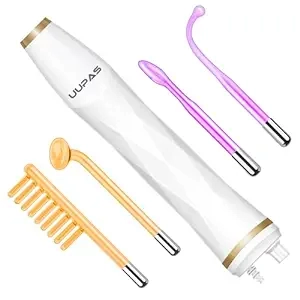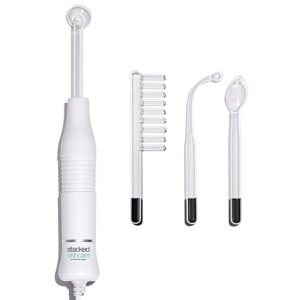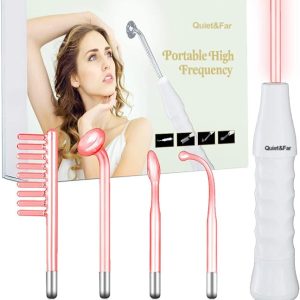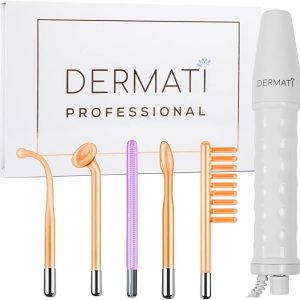Do you know that you can easily do a high frequency facial at your home wothout the need to go to any specialized place for it?
Well, this guide teaches you everything on how to do high frequency facial at home, from the usage of high frequency wands, to the aftercare, side effects, and precatautions, we have got you covered on every aspect of it.
Plus, we’ll also discuss how high-frequency can work wonders for both your skin and hair. Let’s explore together.


How to Do High-Frequency Facial at Home?
High-frequency facials work by applying a mild electrical current to the skin’s surface. This stimulates circulation, boosts collagen production, and promotes oxygenation, addressing concerns like acne and fine lines.
To make it simple for you, here is an effective and easy method to do high frequency facial at home:
| Activity | Description |
|---|---|
| 1. Cleanse | Begin with a gentle cleanser to remove makeup and impurities. |
| 2. Pat Dry | Gently pat your face dry with a clean towel. |
| 3. Exfoliate (optional) | Use a mild exfoliator to slough off dead skin cells. |
| 4. Steam (optional) | Steam your face for 5-10 minutes to open up pores. |
| 5. Prepare the wand | Plug in the high-frequency wand and power it on. Follow manufacturer instructions. |
| 6. Frequency Adjustment | Start at the lowest setting and adjust based on skin sensitivity. |
| 7. Spot Treatment | Target acne or blemishes by holding the wand slightly above the skin, moving in circular motions for 5-10 mins. |
| 8. Overall Facial Massage | Using a suitable attachment, gently massage the entire face in upward circular motions. Focus on areas with fine lines or uneven texture. |
| 9. Serum Application (optional) | Apply a hydrating serum to lock in moisture. |
| 10. Moisturize | Finish with a non-comedogenic moisturizer. |
| 11. Sunscreen | If it’s daytime, apply sunscreen with at least SPF 30. |
How Do You Use a High Frequency Comb at Home?
High-frequency combs typically emit a mild electrical current that promotes circulation, encourages hair growth, and helps maintain a healthy scalp. Here’s a step-by-step method on how to use a the comb while doing high frequency treatment for hair:
- Wash your hair with a gentle shampoo to remove oil, dirt, and styling products.
- Gently pat dry with a clean towel, leaving your hair damp.
- Choose the appropriate attachment for your high-frequency comb. Some combs come with different options for various hair and scalp conditions.
- Power on the high-frequency comb according to the manufacturer’s instructions.
- If your comb has adjustable settings, begin with a low frequency. You can increase it later based on your comfort level.
- Divide your hair into manageable sections using hair clips. This ensures thorough coverage.
- Slowly run the high-frequency comb over each section of your scalp, moving in a gentle, circular motion. Ensure that the comb makes contact with your scalp.
- Continue combing through each section until you cover the entire scalp.
- If you have specific areas of concern (e.g., thinning hair), spend a bit more time on those regions.
- Once you’ve combed your entire scalp, power off the comb and unplug it.
- If desired, you can apply any recommended hair treatment products or oils after using the high-frequency comb.
- Clean the wand and comb attachment according to the manufacturer’s instructions to maintain hygiene.
Note: Follow the specific guidelines provided by the manufacturer for your high-frequency comb model, and if you have any scalp conditions or concerns, consult with a healthcare professional.


What Should I Put On My Face Before High Frequency?
Before using a high-frequency device on your face, you should apply a thin layer of high-frequency gel to the treatment area, if recommended by your specific device. This gel helps the wand glide smoothly over your skin, facilitating effective treatment.
If high-frequency gel is unavailable, you can use alternatives such as:
- Aloe vera gel
- Hydrating Serum
- Witch Hazel
- Unscented Lotion
How Often Can I Use High Frequency on My Face at Home?
For optimal results, the frequency of high-frequency facial treatments at home can vary based on specific skin concerns.
For general maintenance and improved circulation, using the high-frequency device 1 to 3 times per week is sufficient. If you’re targeting acne or breakouts, you can increase the frequency to 4 to 5 times weekly.
For addressing fine lines and wrinkles, 2 to 3 sessions per week should be effective.
Always follow the manufacturer’s guidelines and consult with a dermatologist if you have any underlying skin conditions or concerns. Remember, consistency is key, and allowing your skin time to adapt is crucial for seeing long-term benefits.
Can I Use High Frequency on My Face Everyday?
Using a high-frequency device on your face every day may not be necessary and could potentially lead to these side effects:
- Redness
- Dryness and Peeling
- Sensitivity
- Breakouts
- Burning Sensation
- Inflammation
- Tightness or Discomfort
- Worsening of Existing Conditions
High-frequency treatments are generally effective when used in moderation, allowing the skin time to rejuvenate between sessions.
For most individuals, incorporating high-frequency treatments into their skincare routine 2 to 3 times per week is sufficient for various concerns like improving circulation, addressing acne, or reducing the appearance of fine lines.
However, it’s crucial to pay attention to your skin’s response.
Who Should Not Use High Frequency?
Here are some individuals who should not use high frequency:
- Pregnant individuals
- People with a history of heart disease or pacemakers
- Those with metal implants or plates in the area to be treated
- Individuals with epilepsy or a history of seizures
- People with open wounds, cuts, or infections on the skin
- Those with a history of keloid scarring
- Individuals with a compromised immune system
- People with vascular conditions or diseases
- Those with a sensitivity or allergy to electrical currents or specific materials used in high-frequency devices
Aftercare:
After a high-frequency hair and skin treatment, it’s essential to follow a simple aftercare routine.
For the skin, apply a soothing and hydrating serum to replenish moisture and calm any potential redness. Follow this with a non-comedogenic moisturizer to lock in hydration. Additionally, remember to apply sunscreen with at least SPF 30, especially if the treatment was performed during the day.
For the hair, avoid exposing it to excessive heat styling immediately after the high-frequency session, and use a nourishing hair mask to keep the strands hydrated. Be gentle when brushing or styling to minimize stress on the hair follicles. Consistent aftercare will enhance the benefits of the treatment and promote healthier skin and hair over time.
Conclusion:
In the end, doing high-frequency facials at home is a game-changer. No need for salon drama – our guide makes it super simple. Just follow the steps, and you’re good to go. Forget appointments and enjoy pro-level results from the comfort of your own space.
So, get ready to make your home your personal skincare spot. With this easy routine, you’re just a few steps away from that awesome, healthy glow.





